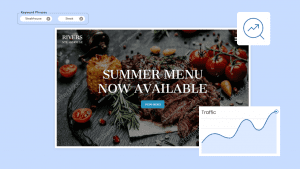Key takeaways:
- Manual lead generation is a tedious process, and software makes it easier for businesses to find prospects.
- The market offers diverse lead generation software, each with unique features, pricing, and best use cases for various business types.
- Selecting the right software requires careful evaluation of factors like analytics, automation, ease of use, cost, flexibility, and specific tools to match your business needs.
As a business owner, you already know how important it is to consistently bring in qualified leads. But manually doing it can be time-consuming, frustrating, and challenging. This is why many sales and marketing teams are turning to lead generation software to automate the process, find the right prospects, and turn interest into action.
With many options available in the market, how do you know which is the best lead generation software? Let’s compare lead generation software along with its core features, pricing tiers, and respective pros and cons.
Here’s a quick overview of the current best lead generation tools that we will tackle below:
| Software | Starting price | Key features | Free trial or free plan available? | Best for |
| HubSpot | $15 | Centralized space Ad management tools Social publishing and monitoring Contact and company management Pipeline and deal tracking. Sequences | Free plan | Businesses that want an all-in-one system without stitching multiple tools together |
| Kaspr | $49 | LinkedIn Chrome Extension CRM integration Bulk lead extraction Task and note management Customizable filters | Free plan | Sales teams, recruiters, and SDRs doing LinkedIn outreach |
| Apollo.io | $49 | Lead generation and contact database Apollo Chrome Extension Website visitor tracking Lead scoring and signaling tools Analytics hub CRM data enrichment AI-powered conversation recording and transcribing Automated sales workflow Sales intelligence | Free plan | B2B sales teams, SDRs, and outbound marketers who need verified data + automation |
| Pipedrive + LeadBooster | $14 | Leads inbox Spreadsheet imports Automatic assignment Scheduler Lead scoring CRM integration Chatbox Reports and insights Marketing automation | 14-day Free trial | Small businesses that focus on CRM and sales |
| OptinMonster | $84 | Easy drag and drop builder Smart triggers Personalized targeting Seamless integrations with other tools Google Analytics integration Account management | None for both; only a 14-day money-back guarantee | Marketing agencies, eCommerce sites, bloggers, and small businesses |
| Hunter | $34 | End-to-end workflow B2B lead database Market segmentation Easy ideal customer profile (ICP) tracking Global coverage Outbound marketing tools | Free plan | B2B marketing campaigns |
| ZoomInfo | Not disclosed; available upon inquiry | Total addressable market (TAM) calculator Lead search filtering Zoominfo directory Live buyer intent engine Modern GTM Index | Free trial and a free plan called ZoomInfo Lite | B2B marketing campaigns |
| Leadpages | $37 | Landing pages templates Leads library A/B testing Lead enrichment Smart team features Real-time analytics Lead management Leadmeter | No free plan, but it has a 14-day free trial | Small to medium businesses |
| Unbounce | $74 | Landing pages A/B testing Smart copy Integrations Smart traffic Templates LeadsRx Insightly CRM | 14-day free trial | Digital marketing agencies |
| Lusha | $22.45 | Data enrichment Lead generation and prospecting tools Browser extension CRMs integrations Compliance and data privacy | No, but offers a free plan | B2B sales and marketing teams |
1. HubSpot
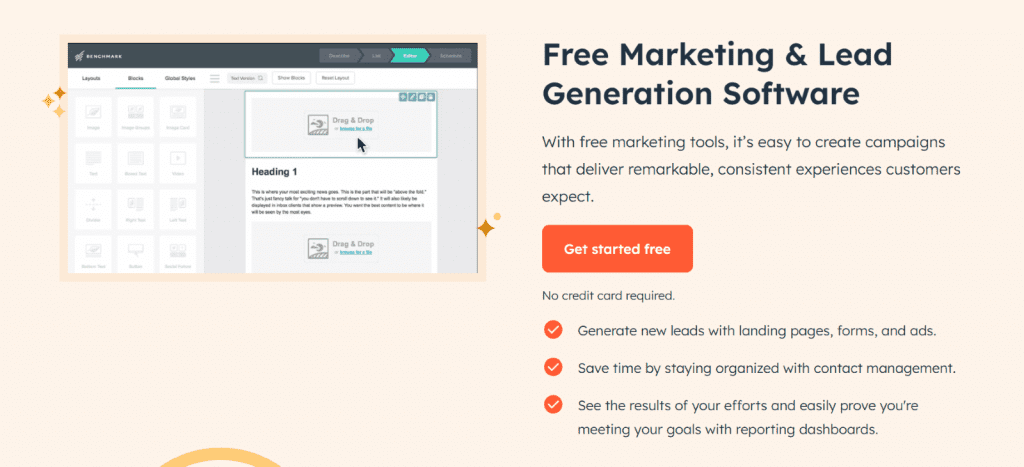
HubSpot offers a wide array of tools and software for marketing teams. Their lead generation features are part of the Marketing Hub, which combines form builders, pop-ups, live chat, email marketing, automation, and CRM integration—all in one centralized platform.
It’s a top choice for businesses that want a full-funnel marketing system where lead capture, nurturing, and conversion happen in a unified environment.
Key features
Here are HubSpot’s notable lead gen tools and features:
- Centralized space. The Marketing Hub provides an organized space to create and manage multiple campaigns across channels.
- Ad management tools. These help businesses create, manage, and track advertising campaigns across various platforms. They provide insights into ad performance and optimize spending.
- Social publishing and monitoring. Users can schedule content for various social media channels and also monitor mentions and engagement.
- Contact and company management. Centralizes all lead and customer information. It organizes contact details, company profiles, and interaction history.
- Pipeline and deal tracking. Like its name suggests, this tool lets sales teams visualize their sales pipeline and track deal progress. This enables efficient management of opportunities through different stages.
- Sequences. This automates personalized email follow-ups and nurture paths. It streamlines communication with prospects. It moves them through the sales funnel without manual effort.
Pricing plans
Does it include a free plan? Yes

HubSpot’s paid plans are categorized into two: For individuals and small teams, and for businesses and enterprises. The tiers for each are:
For individuals and small businesses:
- Marketing Hub Starter. Starts at $15 per month per seat.
- Marketing Hub Professional. $890 per month for 3 seats.
For businesses and enterprises:
- Marketing Hub Professional. $890 per month for 3 core seats.
- Marketing Hub Enterprise. $3,600 per month for 5 core seats.
Plans for businesses and enterprises offer the option to add more core seats for a monthly fee of $50 for the former and $75 for the latter.
Note: Pricing details are accurate as of June 2025. For more updated pricing, visit HubSpot’s website.
| Pros | Cons |
| All-in-one platform for lead generation, nurturing, and conversion | Pricing can be expensive for small businesses |
| Seamless integrations | No built-in prospecting tools |
| Free AI tools | No LinkedIn integration or automation |
| Useful marketing and sales automation | Steep learning curves for beginners |
| No live support for free plans |
2. Kaspr

Kaspr is a lead generation tool built specifically for sales professionals who rely on LinkedIn prospecting. Its Chrome extension allows users to extract email addresses and phone numbers from LinkedIn profiles without a first-degree connection. It’s especially powerful for SDRs, recruiters, and B2B sales teams focused on outreach.
Kaspr also provides general data protection regulation (GDPR) aligned data collection while integrating with popular CRMs and outreach platforms.
Key features
Below are Kaspr’s best lead generation features:
- LinkedIn Chrome Extension. This provides instant access to contact details directly from LinkedIn profiles, Sales Navigator, and Recruiter Lite. It allows users to gather verified emails and phone numbers while browsing.
- CRM integration. Kaspr integrates with popular CRM platforms such as Salesforce, HubSpot, and Pipedrive. This allows for seamless data export and ensures prospect information transfers directly to your existing sales workflows.
- Bulk lead extraction. This streamlines the process of building large, targeted lead lists from various LinkedIn searches and uploaded lists.
- Task and note management. Create tasks and add notes directly to prospect profiles. This helps users organize follow-ups and track interactions efficiently within Kaspr’s dashboard.
- Customizable filters. Kaspr provides various filters to refine lead searches. Users can apply specific criteria to target ideal prospects based on industry, job title, company size, and more.
Pricing plans
Does it include a free plan? Yes

Kaspr’s paid plans are straightforward and based on the number of credits customers want per year. The enterprise tier is also flexible and customizable to meet different needs.
- Starter. $49 per month per user.
- Business. $79 per month per user.
- Enterprise. Available upon inquiry and depending on the customization.
Note: Pricing details are accurate as of June 2025. For more updated pricing, visit Kaspr’s website.
| Pros | Cons |
| Specific to LinkedIn | Not suitable for broader lead gen needs |
| Over 500 million verified and accurate contact data points | Limited functionality without the Chrome extension |
| Comes with a Google Chrome extension |
3. Apollo.io
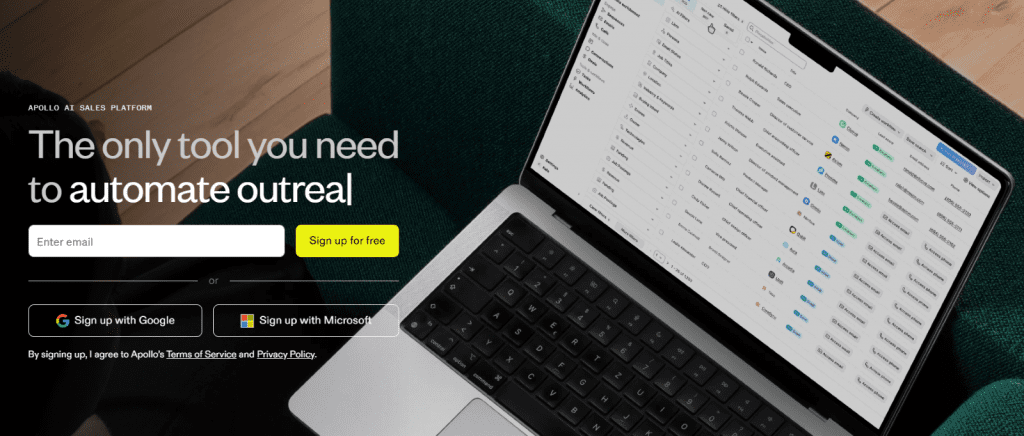
Apollo.io is a powerful lead generation and sales engagement platform that combines a database of verified contacts with advanced outreach and enrichment tools. Designed for B2B sales teams, it enables users to find leads, enrich data, score prospects, and launch automated email sequences on a single platform.
Apollo is ideal for outbound teams who want to scale personalized outreach without sacrificing accuracy or deliverability. Its platform includes intent data, job change alerts, and AI-powered insights to prioritize high-converting leads.
Key features
Here are Apollo.io’s standout core features:
- Lead generation and contact database. Apollo.io offers an extensive database with over 210 million B2B contacts and 35 million companies. Users can search and filter using various criteria to build targeted lead lists.
- Apollo Chrome Extension. This allows users to view and extract contact data directly from LinkedIn profiles and company websites.
- Website visitor tracking. This lets businesses identify and understand who visits their website. This matches IP addresses to companies in Apollo’s database and reveals visitor interest.
- Lead scoring and signaling tools. This automatically scores and prioritizes leads by assigning values based on a lead’s demographic and firmographic attributes, as well as their engagement behaviors (like website visits or email clicks).
- Analytics hub. The platform offers insights into outreach campaign performance. Users can track metrics like open rates, click-through rates, and conversion rates, and build custom reports.
- CRM data enrichment. Users can upload existing contact lists, and Apollo.io adds detailed information from its database. This ensures data accuracy and completeness.
- AI-powered conversation recording and transcribing. The platform automatically captures and analyzes sales conversations. It records calls and meetings, transcribes spoken words into text, and uses AI to analyze conversation content.
- Automated sales workflow. Users can automate sales processes and tasks, including trigger-based actions and task automation.
- Sales intelligence. Apollo.io provides buying intent data and signals to help sales teams identify potential customers. This includes information on recent funding, job changes, and website activity.
Pricing plans
Does it include a free plan? Yes

Apollo.io’s pricing is billed annually and is generally affordable for individuals and small businesses.
- Basic. $49 per month per user
- Professional. $79 per month per user
- Organization. $119 per month per user
Note: Pricing details are accurate as of June 2025. For more updated pricing, visit Apollo.io’s website.
| Pros | Cons |
| Extensive database | Needs frequent monitoring because some data can be outdated |
| Highly targeted lead selections using advanced search filters | Not useful and less effective for niche markets with low online search volume |
| All-in-one outreach and enrichment solution | Interface can feel complex for new users |
4. Pipedrive + LeadBooster
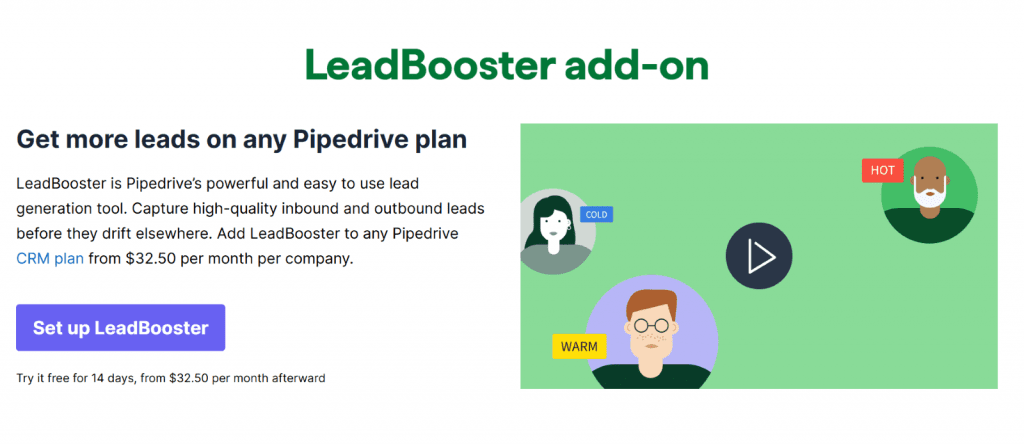
Pipedrive is a sales-focused CRM designed to help sales teams visualize their pipelines, manage deals, and track communications. LeadBooster is an optional Pipedrive add-on that helps you capture, qualify, and manage leads from various online sources before they become sales deals.
Key features
Here are Pipedrive’s advanced features that help generate leads.
- Leads inbox. This is a central hub for all incoming leads generated from various sources (like web forms, chatbots, etc). It’s where sales reps can qualify, filter, sort, and assign leads before converting them into deals in the main pipeline.
- Spreadsheet imports. Pipedrive allows users to import leads, contacts, organizations, and deals from spreadsheets (e.g., CSV files) in bulk. This is important for migrating existing data into the CRM or importing lead lists from other sources.
- Automatic assignment. Automates routing new leads and deals to specific sales representatives or teams based on predefined rules. Users can set rules based on criteria (e.g., lead source, geographical location, industry, or specific lead attributes).
- Scheduler. An appointment booking tool that streamlines meeting arrangements. Sales reps can share their availability links, allowing prospects and clients to book meetings directly into their calendars.
- Lead scoring. Helps prioritize leads by assigning a score based on various criteria. While Pipedrive allows for manual configuration, it also leverages AI (e.g., Pipedrive Pulse, in beta for some features) to automatically score and rank leads based on their conversion likelihood.
- CRM integration. Leads generated through LeadBooster flow directly into the Pipedrive CRM. This supports quick assignment and follow-up.
- Chatbox and live chat. A customizable chatbot and live chat widget. Sales teams can use it to engage website visitors in real time or qualify leads automatically.
- Reports and insights. Reporting and analytics capabilities that help users create custom reports and dashboards to visualize sales performance, track key metrics, and identify trends.
- Marketing automation. While Pipedrive’s core strength is sales, it offers foundational marketing automation features, particularly for lead nurturing. This includes setting up automated email sequences that trigger based on specific lead actions (e.g., a lead enters a particular stage and downloads content).
Pricing plans
Does it include a free plan? No, but they offer a 14-day free trial
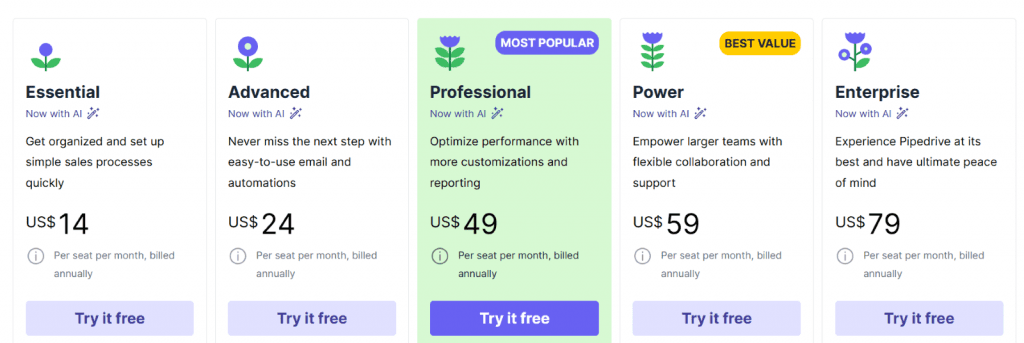
Pipedrive’s paid plans are also billed annually and range depending on the number of users in an account. Leadbooster, the platform’s lead gen tool, is an additional feature that costs $32.50 per month for any of the CRM plans below:
- Essential. $14 per seat per month.
- Advanced. $24 per seat per month
- Professional. $49 per seat per month
- Power. $59 per seat per month
- Enterprise. $79 per seat per month
Note: Pricing details are accurate as of June 2025. For more updated pricing, visit Pipedrive’s website.
| Pros | Cons |
| Low starting price per account for the base CRM tools | No free plans |
| Easy-to-use chatbot builder | Leadbooster is an add-on with a separate payment subscription. |
5. OptinMonster
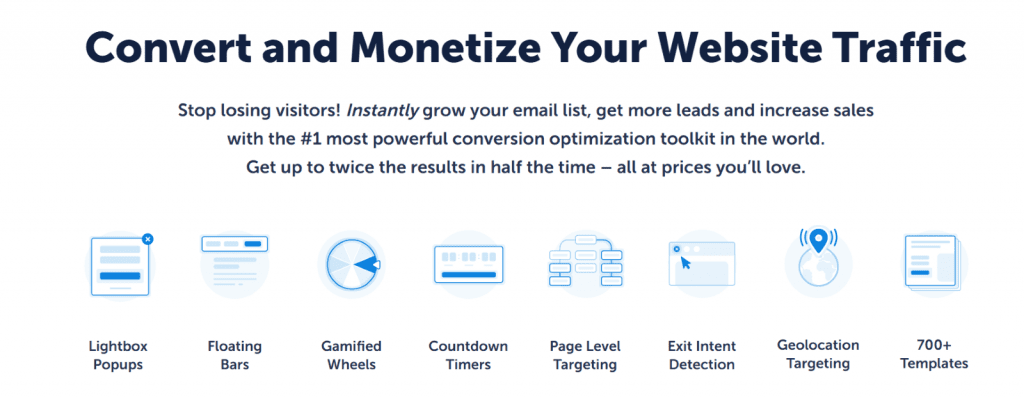
OptinMonster is a conversion optimization tool that helps marketers capture leads directly from their websites. It specializes in building and targeting popups, slide-ins, floating bars, and other on-site campaigns designed to convert visitors into subscribers or customers.
Its targeting rules allow users to display campaigns based on user behavior, referral source, device type, or exit intent. This makes it useful for websites that want to reduce bounce rates or grow email lists without relying on external traffic sources.
Key features
Let’s take a look at OptinMonster’s lead gen and marketing tools.
- Easy drag and drop builder. A user-friendly visual editor allows users to design professional-looking campaigns by adding or removing elements and customizing colors, fonts, images, and layouts to match their brand.
- Smart triggers. This tool helps generate more leads by using smart triggers to display a tailored campaign to prospective customers.
- Personalized targeting. OptinMonster allows users to create targeting rules based on visitor data and behavior. These include geolocation, referral source (e.g., Facebook, Google, or a website), device type, and whether the visitor is new or returning.
- Seamless integrations with other tools. OptinMonster integrates with various native CRMs, ESP, PPC, and ad scripts, Zapier, Webhooks, and the like.
- Google Analytics integration. In addition to integration with the above-mentioned tools, OptinMonster lets users integrate Google Analytics into their dashboard to review their lead-generation strategy and conduct A/B split testing.
- Account management. Working in a team? OptinMonster’s account management has a role-based sub-account access that lets you share the workload.
Pricing plans
Does it include a free plan? No, no free trial either. They only have a 14-day money-back guarantee
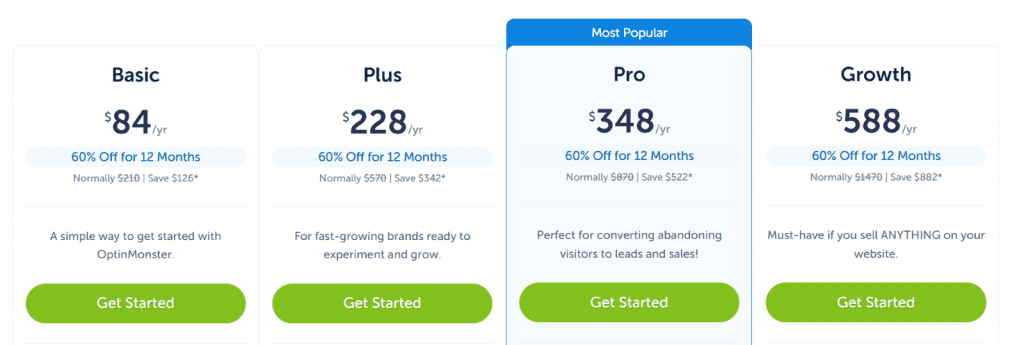
Like other lead generation tools in the list, OptinMonster’s paid plans are direct and billed annually. They only offer paid plans in the following tiers:
- Basic. $84 per year
- Plus. $228 per year
- Pro. $348 per year
- Growth. $588 per year.
Note: Pricing details are accurate as of June 2025. For more updated pricing, visit OptinMonster’s website
| Pros | Cons |
| Easy to deploy across websites with minimal coding | No free trial or free plan |
| Works well for eCommerce and content-based sites | Pricing is relatively high for small businesses that only need basic features |
| Easy integration with other tools and platforms | Steep learning curve for those using the advanced features |
6. Hunter

Hunter.io helps users find email addresses associated with any company or professional, verify their validity, and even send cold email campaigns directly from the platform. It leverages an extensive database of publicly available email addresses and uses algorithms to deduce and verify email formats, making it a valuable tool for outbound outreach.
Key features
Here are this lead generation software’s notable tools and features:
- End-to-end workflow. Hunter covers the full outreach process. Users can find leads, verify email addresses, write outreach emails, and manage follow-ups within the same platform.
- B2B lead database. The system includes a searchable database of publicly available professional email addresses. Each entry includes job title, company domain, and source data.
- Market segmentation. Users can filter leads based on company size, industry, location, and role. This allows more precise targeting in outreach campaigns.
- Easy ideal customer profile (ICP) tracking. Users can define and monitor specific criteria that match their ideal customer profile. The platform prioritizes leads that meet those standards.
- Global coverage. Hunter’s database contains email addresses and contact details from companies and professionals across a wide range of countries and industries.
- Outbound marketing tools. This allows users to build cold email sequences. Users can customize messages, schedule follow-ups, and track engagement without leaving the platform.
Pricing plans
Does it include a free plan? Yes

Hunter’s lead gen paid plans are billed annually. The pricing tiers are as follows in their mon:
- Starter. $34 per month
- Growth. $104 per month
- Scale. $209 per month
Note: Pricing details are accurate as of June 2025. For more updated pricing, visit Hunter’s website.
| Pros | Cons |
| Free plan available | Email marketing campaigns are only possible when connected to Outlook or Gmail |
| Simple user interface | No AI assistant |
| Integrations and add-ons | Pricier paid plans compared to other lead generation tools |
| Email database is frequently updated | |
| Allows a team collaborative environment |
7. ZoomInfo
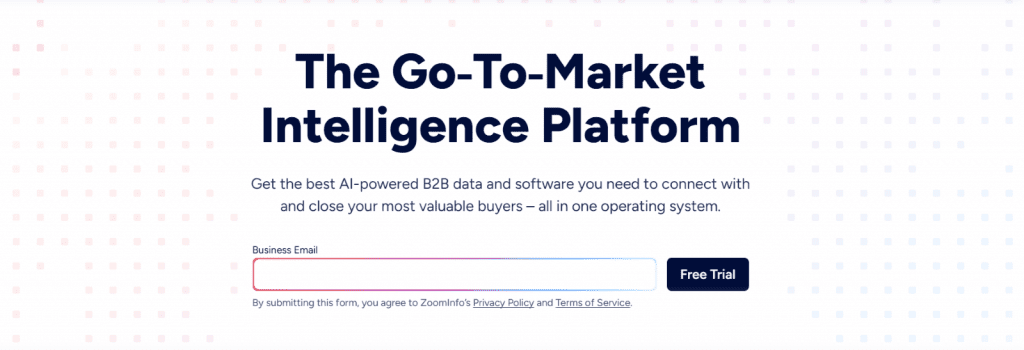
ZoomInfo is a comprehensive go-to-market platform that provides deep insights into companies and professionals. The platform offers a massive, constantly updated AI-powered B2B contact and company information database. Users can also access tools for sales engagement, marketing automation, and operations. Its goal is to help businesses identify, acquire, and grow their customers by providing actionable intelligence at every stage of the go-to-market process.
Key features
Here are some of the lead generation tool’s notable features:
- Total addressable market (TAM) calculator. This tool defines and quantifies your potential market size. It estimates the number of companies and contacts within a specific market segment, aiding strategic planning.
- Lead search filtering. This tool pinpoints ideal leads from ZoomInfo’s vast database. Users apply filters like industry, brands, company ratings, job title, company size, and technologies to build highly targeted prospect lists.
- Zoominfo directory. As its name suggests, it provides access to ZoomInfo’s million contacts, detailed profiles, and verified contact information.
- Live buyer intent engine. This tool identifies companies actively researching solutions. It monitors online behaviors and content consumption to flag “in-market” buyers
- B2B database. ZoomInfo has an extensive collection of company and contact data. It includes millions of accurate profiles with emails, direct dials, and company information.
- Intent data. These show behavioral data that signal company interest. Additionally, they show when a company is actively researching topics or solutions.
- CRM integrations. ZoomInfo connects seamlessly with popular CRM systems like Salesforce and HubSpot. This allows automated data synchronization, enrichment of existing records, and streamlined workflows directly within your CRM environment.
Pricing plans
Does it include a free plan? Yes, but only limited to 10 contacts

Unlike the other lead generation software on this list, ZoomInfo is more discrete about its paid plan pricing. You will need to provide your business email, full name, phone number, and job title to send an inquiry.
Note: Pricing details are accurate as of June 2025. For more updated pricing, visit ZoomInfo.
| Pros | Cons |
| Accurate contact information | No pricing transparency |
| Useful intent data | Limited free plan contact details |
| Requires sign-ups to inquire about pricing |
8. Leadpages

Leadpages is an online platform for building high-converting web pages. It empowers businesses and marketers to create landing pages, pop-ups, alert bars, and full websites without using any code. The platform streamlines lead generation and sales by efficiently collecting prospect information and connecting with vital sales systems.
It offers intuitive tools and well-designed templates. These help users quickly launch effective campaigns. Leadpages maximizes online marketing efforts even without extensive technical knowledge.
Key features
Here are a few features of Leadpage’s lead gen tools:
- Landing pages templates. The platform offers access to a large library of professionally designed and mobile-responsive templates. These are optimized for conversions across various industries and campaign types.
- Leads library. This centralizes all leads captured from pages, pop-ups, and websites. It allows users to search, sort, and manage lead data efficiently, which eliminates the need for separate spreadsheets.
- A/B testing. Leadpages provides A/B testing to optimize page performance. It compares different versions of landing pages. This identifies the most effective designs, content, or calls-to-action.
- Lead enrichment. This tool automatically enhances leads with demographic and firmographic data, which improves lead qualification and personalizes outreach.
- Smart team features. These facilitate team collaboration within the platform by allowing real-time input, approvals, and notifications.
- Real-time analytics. This monitors page performance, traffic sources, and conversion rates instantly. Users then make data-driven decisions to optimize campaigns.
- Lead management. This provides tools to organize, search, and filter leads directly within the platform. It streamlines lead data access and use for follow-up actions.
- Leadmeter. This provides real-time conversion recommendations during page building. It analyzes page content against a vast database, rates conversion potential, and offers step-by-step optimization guidance.
Pricing plans
Does it include a free plan? No, but they offer a 14-day free trial

Leadpages paid plans have monthly or yearly payment options for the following tiers:
- Standard. $37 per month
- Pro. $74 per month
- Custom. Depends on the features and requests.
Note: Pricing details are accurate as of June 2025. For more updated pricing, visit Leadpages
| Pros | Cons |
| Beginner-friendly | Slow page editor |
| Over 250+ templates available | Limited widget selection |
| Simple A/B testing | A/B testing is not unlimited for all plans |
9. Unbounce

Unbounce is a powerful platform for conversion optimization in digital marketing. It lets marketers build, test, and improve high-converting landing pages. It also offers other lead generation assets like pop-ups and sticky bars.
The platform significantly boosts conversion rates for businesses. It helps generate more leads and sales.
Key features
Here are a few of this lead generation platform’s main tools:
- Landing pages. The platform centers on specialized web pages designed for single marketing goals. These pages capture leads or drive specific actions, such as form submissions or purchases.
- A/B testing. Unbounce provides A/B testing to optimize page performance. It compares different versions of landing pages. This identifies the most effective designs, content, or calls-to-action.
- Smart copy. This AI-assisted feature generates content for landing pages, ads, and email.
- Integrations. Unbounce connects with popular marketing tools like CRMs, email marketing platforms, and analytics systems. This ensures seamless data flow and workflow automation.
- Smart traffic. This AI-powered feature automatically routes visitors to the landing page variant most likely to convert them. It uses machine learning to improve conversion rates over time.
- Templates. Unbounce offers a diverse library of pre-designed, mobile-responsive templates. These templates provide a strong foundation for various campaign types and industries.
- LeadsRx. This is Unbounce’s marketing attribution solution. It provides multi-touch attribution and customer journey analytics. This offers unbiased insights across all marketing channels.
- Insightly CRM. Unbounce integrates with Insightly CRM. This allows for seamless lead capture and management directly within Insightly. It helps streamline lead nurturing and conversion processes.
Pricing plans
Does it include a free plan? No, but there’s a 14-day free trial for all plans.

Unbounce’s paid plans can be purchased either monthly or yearly. The tiers are the following:
- Build. $74 per month for yearly; $79 per month for monthly
- Experiment. $112 per month for yearly; $119 per month for monthly
- Optimize. $187 per month for yearly; $199 per month for monthly
- Agency. Custom pricing.
Note: Pricing details are accurate as of June 2025. For more updated pricing, visit Unbounce
| Pros | Cons |
| Intuitive landing page builder | The entry-level tier is pricier than other platforms |
| Beginner-friendly UI | No free plan |
| Wide integration selection | |
| Customizable templates for popups and sticky bars |
10. Lusha
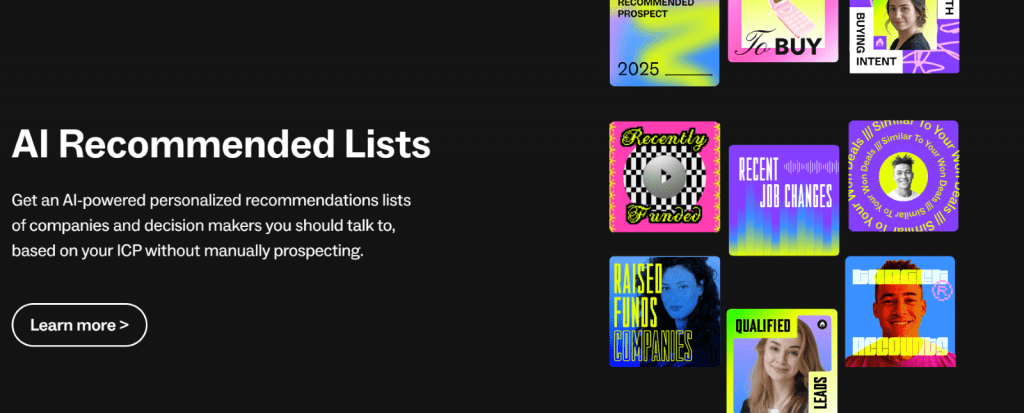
Lusha is a sales intelligence platform. It provides accurate B2B contact and company information for sales, marketing, and recruitment teams. Users get access to a large databse filled with verified email addresses and phone numbers. Lusha is also one of the few lead generation platforms that have Chrome extension for LinkedIn and direct CRM integration.
Key features
Here are Lusha’s useful lead generation tools:
- Data enrichment. Lusha automatically enriches incomplete or existing B2B contact and company records. It also supplements missing data points like direct dials, email addresses, and firmographic details.
- Lead generation and prospecting tools. The platform provides advanced search filters for its database of B2B contacts. Users find target prospects by industry, job title, location, or company size.
- Browser extension. This convenient extension extracts contact information directly from LinkedIn profiles, company websites, and CRM records. It streamlines lead discovery during online research.
- CRMs integrations. Lusha connects seamlessly with popular CRM systems such as Salesforce, HubSpot, and Pipedrive. This allows for automated data synchronization and direct export of leads.
- Compliance and data privacy. Lusha maintains strong data privacy standards and ensures compliance with major regulations, such as GDPR and the California Consumer Privacy Act (CCPA).
Pricing plans
Does it include a free plan? Yes, but only offers a maximum of 50 credits per month.
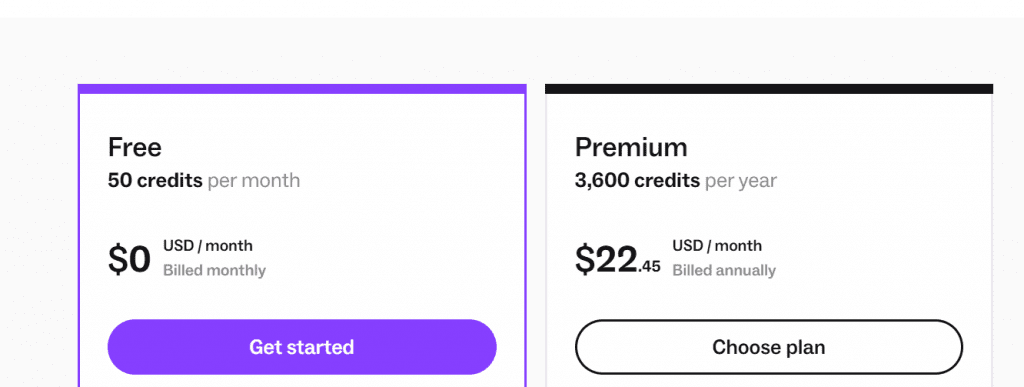
Lusha’s pricing structure and plans depend on the number of credits per year. For premium plans, the minimum credits per year is 3,600 for $22.45 monthly (for yearly plans), and the maximum is around 120,000 credits per year for $604.45 monthly (for yearly plans).
Note: Pricing details are accurate as of June 2025. For more updated pricing, visit Lusha’s website
| Pros | Cons |
| Flexible payment plans | Pricey plans for small businesses |
| Available free plan | Data coverage limitations and random cases of outdated data |
| Ease of use | Credit-based system might limit usage for some users |
| Data accuracy |
How to choose the right lead generation software
Now that you’re familiar with some of the best lead generation tools and platforms in the market, the next step is choosing the best one for you. Keep in mind that there’s no single best answer, as each platform offers different features for various needs.
However, it’s important to consider various factors before choosing a lead generation system to get the most out of it. Make sure to consider:
Analytics
The platform should offer deep insights into lead sources, conversion rates, and return on investment (ROI). This clear reporting identifies effective strategies. This is particularly helpful for a rapidly growing eCommerce business running multiple ad campaigns that need in-depth analytics. They provide insights to optimize strategies continuously and personalize customer journeys.
Automation
Prioritize strong automation to streamline repetitive tasks and scale lead generation efforts. The platform should have an option to automate lead-nurturing sequences, personalize email outreach, or provide seamless data entry.
Ease of use
Select a platform with an intuitive interface to ensure quick adoption and high team productivity. Setup, navigation, and integration into existing workflows must be straightforward and easy to navigate for those with limited tech proficiency.
Cost
Carefully evaluate pricing models against your specific budget and projected lead volume. Always consider subscription tiers, credit systems (assess usage impact on cost), and any hidden or add-on costs.
Flexibility
Seek a platform that adapts to your evolving business needs and future growth. It must offer robust customization options that allow for tailoring processes. Broad API access and seamless integration with existing marketing and sales tools are important—and particularly helpful for an established B2B services company with a customized CRM.
Tools
Consider the specific tools included in the platform. These range from landing page builders and email marketing tools to lead scoring and CRM synchronization features. Each tool serves a distinct purpose in the lead generation funnel.
Score the best leads for your business
Having reliable lead generation software is useful for attracting quality leads and converting them into sales funnels. This powerful solution automates processes and pushes prospect interest into decisive action. Using these tools along with other marketing strategies helps build a powerful lead generation strategy.
And if you want to strengthen your lead generation strategy, Network Solutions has various tools and services like SEO, pay-per-click advertising, and business directories to drive greater online visibility and secure more qualified leads.
Frequently asked questions
Lead generation is the process of attracting and converting strangers into individuals who have shown interest in a company’s products or services. It involves identifying potential customers, engaging them with valuable content, and capturing their contact information with the goal of nurturing them into paying customers.
The best lead management software aligns with your business needs. Look for a tool that offers features like automation, pipeline tracking, and detailed reporting.
It should help you organize and nurture leads, from initial contact to conversion, with user-friendly dashboards and integration with other platforms.
The most effective form of lead generation depends on your audience, but inbound marketing is a strong choice. This method involves creating valuable content to attract potential customers.
Other effective approaches include using social media, email campaigns, and paid advertising. The key is to choose methods that align with where your target audience spends their time and how they prefer to engage.
The best AI tools use features like chatbots to engage visitors, predictive analytics to identify potential leads, and automation to follow up with prospects. The right AI tool will help you qualify leads, enhance customer interactions, and improve conversion rates by efficiently managing the lead funnel.
ChatGPT cannot generate leads directly by finding contact information or building lead lists from scratch. It does not have access to real-time databases or the Internet for direct prospecting (unless specifically integrated with other tools via plugins or APIs, which extends its core capabilities).
However, ChatGPT can significantly assist in various aspects of lead generation, such as:
• Content creation
• Market research
• Lead qualification assistance
• Brainstorming
• Personalized messaging


